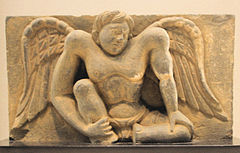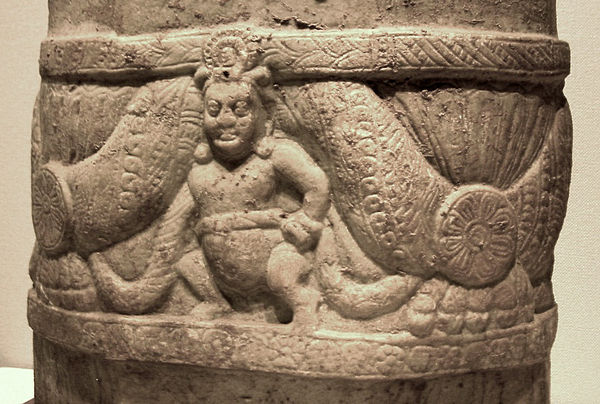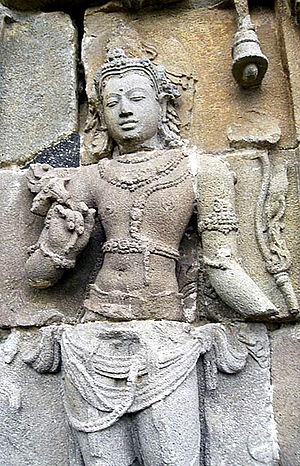Το 2009, αμερικανικές μυστικές υπηρεσίες έδωσαν στην ΕΥΠ πληροφορίες ότι Ουκρανοί μαφιόζοι είχαν στην κατοχή τους έτοιμες προς πώληση περί τις 30 ελληνικές αρχαιότητες. Η ΕΥΠ ενημέρωσε αμέσως τον αρχηγό της ΕΛ.ΑΣ., το υπουργείο Πολιτισμού και τον τότε αρμόδιο υπουργό Αντώνη Σαμαρά. Την υπόθεση ανέλαβε να χειριστεί ο εξ απορρήτων του και σύμβουλός του, Χρύσανθος Λαζαρίδης, σε συνεργασία με την αρχαιολόγο «Κατερίνα», η οποία ήταν τότε διορισμένη στο γραφείο υπουργού και δεν ανήκε στους αρχαιολόγους του ΥΠΠΟ.
«Ο Λαζαρίδης με την “Κατερίνα” είχαν εγκατασταθεί στη σοφίτα του κτιρίου της Μπουμπουλίνας, απομονωμένοι από τους άλλους υπαλλήλους και κανείς δεν γνώριζε με τι ακριβώς ασχολούνται. Οι αρχαιολόγοι είχαν ονομάσει τη σοφίτα “γιάφκα”, καθώς ήταν μακριά από τα αδιάκριτα βλέμματα και επικρατούσε μεγάλη μυστικότητα», είπε αρχαιολόγος με μακρά θητεία στο κεντρικό κτίριο του υπουργείου.

Το περιβάλλον του Σαμαρά, με τη σύμφωνη γνώμη του γενικού γραμματέα Θοδωρή Δραβίλλα, αποφάσισε τότε να κρατήσει στεγανή την υπόθεση και να μην ενημερώσει (όπως είναι η συνήθης διαδικασία) το τμήμα Δίωξης Αρχαιοκαπηλίας της Ασφάλειας που είχε αποκτήσει τα περασμένα χρόνια σημαντική εμπειρία από διεθνή συνεργασία και είχε σημειώσει πολύ σημαντικές επιτυχίες στη δίωξη του διασυνοριακού εγκλήματος της αρχαιοκαπηλίας, όπως -μεταξύ πολλών άλλων- η υπόθεση του Μουσείου Getty, η υπόθεση «Shelby White» και φυσικά η πολύκροτη υπόθεση της Σχοινούσας (που για άγνωστους λόγους δεν έφτασε ποτέ στο ακροατήριο). Η «γιάφκα» επέλεξε να συνεργαστεί μόνο με την ΕΥΠ, καθώς αυτό θα διευκόλυνε τη στεγανότητα της υπόθεσης.
Οι πολιτικές εξελίξεις και οι πρόωρες εκλογές δεν επέτρεψαν να προχωρήσει η έρευνα. Η κυβέρνηση Καραμανλή παραιτήθηκε, οι εκλογές τον Οκτώβριο του 2009 ανέδειξαν νικητή τον Γιώργο Παπανδρέου και νέος υπουργός Πολιτισμού ανέλαβε ο Παύλος Γερουλάνος.
Με παρέμβαση του Αντώνη Σαμαρά, ο οποίος επικαλέστηκε την υπόθεση της Ουκρανίας, παρέμεινε στην Μπουμπουλίνας η «Κατερίνα», ως χειρίστρια του επίμαχου φακέλου, η οποία διορίστηκε σύμβουλος και του νέου υπουργού. Παράλληλα, επανήλθε ως γενική γραμματέας του υπουργείου η Λίνα Μενδώνη, στενή συνεργάτιδα του Ευάγγελου Βενιζέλου που είχε υπηρετήσει επί υπουργίας του στην ίδια θέση (1999-2004).
Το 2010, η υπόθεση της Ουκρανίας αναθερμάνθηκε. Η «Κατερίνα» σε συνεργασία με τον «Ιακώβ», πληροφοριοδότη από τη Θεσσαλονίκη, και με τη συνδρομή της Κατεχάκη, όργωσε τη Βόρεια Ελλάδα προς αναζήτηση του τάφου από όπου θα μπορούσαν να προέρχονται οι ελληνικές αρχαιότητες που έφτασαν στα χέρια των Ουκρανών μαφιόζων. Κοριοί «άκουγαν» υπόπτους, πληροφοριοδότες ενεργοποιήθηκαν, οργανώθηκαν αποστολές στη Μακεδονία και τη Θράκη, αλλά δεν προέκυψε τίποτα αξιοποιήσιμο.
Μια εθνική υπόθεση
«Γνωρίζαμε ότι η συγκεκριμένη σύμβουλος του υπουργού έκανε ταξίδια, υπό καθεστώς μυστικότητας στη Βόρεια Ελλάδα, αλλά επισήμως μας κρατούσαν στο σκοτάδι. Αρχαιολόγος, στέλεχος της Διεύθυνσης Τεκμηρίωσης που συνεργαζόταν με την “Κατερίνα”, διέδιδε ότι “το υπουργείο δεν είχε εμπιστοσύνη στην Ασφάλεια” και ότι “δεν συνεργαζόμασταν όπως πρέπει”», είπε έμπειρος αστυνομικός που υπηρέτησε τότε στην Δίωξη Αρχαιοκαπηλίας της ΓΑΔΑ.
Αλλος αξιωματικός πρόσθεσε ότι «από το ΥΠΠΟ ζητούσαν επίμονα να μάθουν κάθε λεπτομέρεια για τις επιχειρήσεις της αστυνομίας, κάτι απολύτως ασυνήθιστο. Ηταν σαν να ήθελαν να υποκαταστήσουν τον ρόλο μας, να ποδηγετήσουν το τμήμα Δίωξης Αρχαιοκαπηλίας, να έχει το υπουργείο Πολιτισμού τον πλήρη έλεγχο. Υπήρχε επίσης μια ανεξήγητη απόσταση εμπιστοσύνης που δεν ήταν κατανοητή».
Στα τέλη της χρονιάς αποφασίστηκε να πραγματοποιηθεί αποστολή στην Ουκρανία και να γίνει επαφή με τους αρχαιοκάπηλους. Τότε επελέγη μια πρωτοφανής διαδικασία. Αντί να μεταβεί στέλεχος των ελληνικών Αρχών δίωξης, που είναι εκπαιδευμένοι και εντεταλμένοι για αυτές τις επιχειρήσεις, αποφασίστηκε να εμφανιστεί ως υποψήφια αγοράστρια των λεηλατημένων αρχαιοτήτων η αρχαιολόγος «Κατερίνα» που μετέβη στο Κίεβο και έκανε επαφή με τους μαφιόζους. Πώς επέτρεψαν να μεταβεί σε τέτοια αποστολή μετακλητός υπάλληλος κι όχι αστυνομικός; Ποιος θα είχε την ευθύνη, αν κάτι δεν πήγαινε καλά;
Η «Κατερίνα» συναντήθηκε με δύο μαφιόζους τον Φεβρουάριο του 2011, που της έδειξαν τις αρχαιότητες προς πώληση. Η συνολική αξία τους -όπως είπαν- ήταν της τάξης πολλών δεκάδων εκατ. ευρώ. Οι μαφιόζοι έκαναν και μια εντελώς «αντιεπαγγελματική» κίνηση. Δέχτηκαν να φωτογραφηθούν με ακάλυπτα πρόσωπα μπροστά από τα αρχαία.
Πληροφορίες αναφέρουν πως οι δύο Ουκρανοί (που χρησιμοποίησαν ελληνικά ψευδώνυμα) ισχυρίστηκαν ότι έχουν ισχυρές πολιτικές διασυνδέσεις με το περιβάλλον της πρωθυπουργού Γιούλια Τιμοσένκο και έδωσαν ακόμη και το e-mail συνδέσμου τους, για να προχωρήσουν οι διαπραγματεύσεις για την αγοραπωλησία.

Η «Κατερίνα» επέστρεψε στην Ελλάδα με τις δύο φωτογραφίες, αλλά το υπουργείο Πολιτισμού δεν έκανε το αυτονόητο. Να στείλει -δηλαδή- τα αποδεικτικά στοιχεία στην Interpol και να ζητήσει αστυνομική συνεργασία για τη σύλληψη των αρχαιοκαπήλων και τον επαναπατρισμό των ελληνικών -όπως πίστευαν- αρχαιοτήτων.
Για να αποδειχθεί η ελληνική προέλευση, με την εδαφική έννοια του όρου κι όχι όσον αφορά την ελληνική τέχνη (που θα μπορούσε να είναι από τον ευρύτερο «ελληνικό κόσμο» της εποχής, ο οποίος δεν ταυτίζεται διόλου με τα σύνορα του σημερινού ελληνικού κράτους), έπρεπε να βρεθεί ο τάφος προέλευσης σε ελληνικό έδαφος. Αυτό ήταν απαραίτητο για τον επαναπατρισμό, όχι όμως και για τη σύλληψη των αρχαιοκαπήλων και τη δέσμευση του χρυσού θησαυρού, μέχρι να αποδειχθεί η τοποθεσία της λαθρανασκαφής.
 Τις φωτογραφίες του επίμαχου CD (το οποίο έχει στην κατοχή της η «Εφ.Συν.») τις δείξαμε σε επιφανή αρχαιολόγο της Μακεδονίας. Επειτα από πολύωρη επισκόπηση, αποφάνθηκε ότι «πρόκειται για ετερόκλητο σύνολο σκυθικών, ίσως θρακικών και ελληνικών αρχαιοτήτων |
Τις φωτογραφίες του επίμαχου CD (το οποίο έχει στην κατοχή της η «Εφ.Συν.») τις δείξαμε σε επιφανή αρχαιολόγο της Μακεδονίας. Επειτα από πολύωρη επισκόπηση, αποφάνθηκε ότι «πρόκειται για ετερόκλητο σύνολο σκυθικών, ίσως θρακικών και ελληνικών αρχαιοτήτων |
Ο στόχος πλέον ήταν να βρεθεί ο τάφος προέλευσης, που άρχισε να παίρνει μυθικές διαστάσεις. Αλλη μια φορά, η σκοπιμότητα επικράτησε της συνήθους διαδικασίας. Ομως, όσο καθυστερούσε ο εντοπισμός του τάφου τόσο μεγάλωνε ο κίνδυνος να πωληθούν οι αρχαιότητες στην παράνομη διεθνή αγορά. Εν τω μεταξύ, η ΕΥΠ είχε διαθέσει μυστικό κονδύλι 1,2 εκατ. ευρώ για την επιχείρηση, την οποία είχε χαρακτηρίσει «εθνικής σημασίας».
Ο «τάφος της Ολυμπιάδας»
Τον Ιούνιο του 2011, αρχαιοκάπηλος προσέγγισε την «Ηρα», αρχαιοπώλη της Αθήνας, και της έδωσε την πληροφορία πως Ουκρανοί μαφιόζοι πουλάνε ελληνικό θησαυρό με εκατοντάδες χρυσά αντικείμενα αμύθητης αξίας και λίγο αργότερα της έδωσε ένα CD με το «εμπόρευμα». Το CD είχε 372 φωτογραφίες των αρχαιοτήτων, ορισμένες από τις οποίες εμφανίζονταν και στις δύο αρχικές φωτογραφίες που είχε φέρει η «Κατερίνα» από το Κίεβο. Ομως τώρα τα αρχαία ήταν πολύ περισσότερα.
Η «Ηρα» έκλεισε ραντεβού με τη Λίνα Μενδώνη στο γραφείο της στην Μπουμπουλίνας και της έδωσε το CD, παρουσία της «Κατερίνας». Από τα στοιχεία, η «Κατερίνα» και οι εμπλεκόμενοι στην υπόθεση φέρονται να έβγαλαν το συμπέρασμα πως, για να δικαιολογηθεί ένα τόσο μεγάλο σύνολο χρυσών αντικειμένων αμύθητης αξίας, κυρίως κοσμημάτων, θα έπρεπε να προέρχονται από έναν γυναικείο βασιλικό τάφο, και μάλιστα της Ολυμπιάδας, της μητέρας του Μεγάλου Αλεξάνδρου.
Οι έρευνες εντάθηκαν στη Βόρεια Ελλάδα για την ανακάλυψη του «τάφου της Ολυμπιάδας» χωρίς αποτέλεσμα και το 2012, με τον Σαμαρά πλέον πρωθυπουργό, τον Θοδωρή Δραβίλλα διοικητή της ΕΥΠ, τη Λίνα Μενδώνη αμετακίνητη στο υπουργείο Πολιτισμού και την «Κατερίνα» να πραγματοποιεί νέες μυστικές αποστολές και στο εξωτερικό (Ελβετία και Λίχτενσταϊν) για τη συλλογή στοιχείων.
Σε υπηρεσιακά έγγραφα της εποχής αναφέρεται πλέον σαφώς ότι η Αθήνα συνδέει τα ουκρανικά αρχαία με τάφο στην Ελλάδα από όπου και προέρχονται. Είναι μια πεποίθηση που ποτέ δεν τεκμηριώθηκε επαρκώς, καθώς υπήρχαν ενδείξεις που μάλλον έδειχναν προς την ακριβώς αντίθετη κατεύθυνση: πως κάτι ύποπτο συνέβαινε και πως τα αρχαία από την Ουκρανία, ούτε προέρχονταν από την Ελλάδα ούτε και ήταν αυθεντικά, τουλάχιστον στο μεγαλύτερο μέρος τους.
Τον Ιανουάριο 2013 έγινε σύσκεψη στο γραφείο του Σαμαρά, με τη συμμετοχή του πρωθυπουργού, της Λίνας Μενδώνη, του Χρύσανθου Λαζαρίδη και της «Κατερίνας», που -εν τω μεταξύ- είχε διορισθεί ειδική σύμβουλος στου Μαξίμου. Εκεί έγινε η παρουσίαση της υπόθεσης στον πρωθυπουργό και η επίδειξη των φωτογραφιών του CD που είχε φέρει η «Ηρα».
Σύσκεψη-φιάσκο στο Μαξίμου
Στη σύσκεψη είχε κληθεί και επιφανής αρχαιολόγος με ειδίκευση τις αρχαιότητες της Μακεδονίας, η οποία πρώτη φορά είδε τις φωτογραφίες του υποτιθέμενου θησαυρού του «τάφου της Ολυμπιάδας». Η σύσκεψη κατέληξε σε φιάσκο, καθώς η αρχαιολόγος -σύμφωνα με πληροφορίες- χαρακτήρισε τον θησαυρό «ετερόκλητο σύνολο που δεν προέρχεται από την Ελλάδα». Αμφισβήτησε επίσης την αυθεντικότητα των αρχαιοτήτων.
Τις φωτογραφίες του επίμαχου CD (το οποίο έχει στην κατοχή της η «Εφ.Συν.») τις δείξαμε σε άλλον επίσης επιφανή αρχαιολόγο της Μακεδονίας. Επειτα από πολύωρη επισκόπηση, αποφάνθηκε ότι «πρόκειται για ετερόκλητο σύνολο, σκυθικών, ίσως θρακικών και ελληνικών αρχαιοτήτων από τις αποικίες της περιοχής της Κριμαίας και πιθανώς ορισμένα πλαστά, σύγχρονα αντίγραφα».
Οι φωτογραφίες δεν επαρκούν για μια επιστημονική και σίγουρη εκτίμηση, αλλά ορισμένες κολλήσεις χρυσών αντικειμένων δεν έμοιαζαν με εκείνες που χρησιμοποιούσαν στην αρχαία εποχή.

«Η παντελής έλλειψη κεραμικών ή χάλκινων αντικειμένων από ένα σύνολο εκατοντάδων αρχαιοτήτων που υποτίθεται ότι βρέθηκαν σε έναν τάφο, επίσης δεν είναι κάτι σύνηθες. Επιπλέον, πολλά αντικείμενα που απεικονίζονται στις φωτογραφίες είναι κόπιες από το Μουσείο Ερμιτάζ, ελληνικής ή σκυθικής τέχνης από την περιοχή της Κριμαίας, ενώ άλλα θυμίζουν έντονα αρχαιότητες που έχουν δημοσιευτεί στο κλασικό βιβλίο των Dyfri Williams και Jack Ogden, “Greek gold: jewelry of the classical world”, μια σύμπτωση που μας κινεί πολλές υποψίες», όπως μας είπε ο αρχαιολόγος.

Αλλη αρχαιολόγος, από τις πλέον έμπειρες στη μικροτεχνία, εκτίμησε ότι η συντριπτική πλειονότητα των αρχαιοτήτων του επίμαχου CD «είναι βόρεια, από την Κριμαία, με πολλά σκυθικά και “βαρβαρικά” κομμάτια. Δύο χρυσά, βαριά περιδέραια και τρία ακόμη κοσμήματα θα μπορούσαν να προέρχονται από μακεδονικό εργαστήριο του 4ου αιώνα, αλλά και πάλι, αυτού του τύπου τα σχέδια, ταξίδευαν στον ευρύτερο ελληνιστικό κόσμο και απαντώνται και σε άλλες περιοχές, πέραν της Μακεδονίας [το χρυσό περιδέραιο που υπάρχει στις φωτογραφίες του CD είναι σχεδόν πανομοιότυπο με αντίστοιχο που εκτίθεται στο Μουσείο Ερμιτάζ].

Επίσης, ο θησαυρός δεν μπορεί να προερχόταν από έναν τάφο και γιατί τα αντικείμενα διέτρεχαν τουλάχιστον δύο και και τρεις αιώνες χρονολόγησης». Η αρχαιολόγος τόνισε πως άμα δεν πιάσει στα χέρια της τα κοσμήματα και αν δεν τα μελετήσει με άνεση χρόνου διά ζώσης και όχι από φωτογραφίες, δεν μπορεί να αποφανθεί για την αυθεντικότητα. Αλλωστε, τα χρυσά κοσμήματα είναι εύκολο να αντιγραφούν. Ερευνα με ειδικά μηχανήματα για τον έλεγχο του κράματος χρυσού είναι απαραίτητες.
Φιλοδοξία και εμμονές
Ο πρωθυπουργός -προς τιμήν του- έθεσε τότε (πρόσκαιρο) τέλος στη φιλοδοξία των συμβούλων του και του περιβάλλοντός του, οι οποίοι ίσως προσδοκούσαν να συνδεθεί το όνομα του Σαμαρά με μια σημαντική ανακάλυψη στη Μακεδονία, τύπου Ανδρόνικου-Καραμανλή. Ομως κάποιοι επέμεναν. Τα «Παραπολιτικά» είχαν γράψει μήνες μετά, σε ρεπορτάζ από το συνέδριο της Ν.Δ. στη Χαλκιδική το 2014, πως ο Χρύσανθος Λαζαρίδης έλεγε σε πηγαδάκια: «Περιμένετε και θα δείτε. Μια ανακάλυψη μπορεί να αλλάξει την ιστορία της Μακεδονίας».
Η επιχείρηση δεν έληξε, παρά το άδοξο τέλος της σύσκεψης στου Μαξίμου. Η εμμονή κυριάρχησε των στοιχείων. Οπως κάνει κάθε έμπειρος γραφειοκράτης, όταν μια πρόταση προς τα «επάνω» απορρίπτεται, την επαναφέρει μέσω άλλου δρόμου.
Στις 12 Απριλίου 2013, ο τότε υπουργός Πολιτισμού Κώστας Τζαβάρας, στέλνει απόρρητη επιστολή στον υπουργό Προστασίας του Πολίτη, Νίκο Δένδια, τον ενημερώνει για την εξέλιξη των ερευνών για την «Επιχείρηση Τάφοι» και ζητάει τη συνδρομή του. Μεταξύ πολλών άλλων, αναφέρεται ότι αντικείμενα (λεηλατημένες ελληνικές αρχαιότητες) «διατίθεντο σε εμάς προς πώληση από Ελληνες στο εσωτερικό τον Φεβρουάριο-Μάρτιο 2013. Τα ίδια αντικείμενα διατίθενται πλέον από το κύκλωμα κατοχής και εμπορίας εξωτερικού, στο οποίο έχουμε διεισδύσει…».
Αλήθεια, το «διατίθεντο σε εμάς» τι ακριβώς σημαίνει και ποια ιδιότητα είχαν τα πρόσωπα πίσω από το «εμάς»; Και γιατί δεν πήγε αμέσως η υπόθεση στον εισαγγελέα; Επίσης, στην επιστολή Τζαβάρα προς Δένδια περιέχονται συνημμένες φωτογραφίες-«αποδεικτικά στοιχεία», που παραπέμπουν -μεταξύ άλλων- και σε αρχαιότητες μη ελληνικές, ίσως και πλαστές. Η επιστολή μεταφέρει εκτιμήσεις ακόμη και για την εμπλοκή του υιού Μιλόσεβιτς στην αγορά των αρχαιοτήτων. Ηταν «ο δράκος που έλειπε από το παραμύθι»; Αν δεν ήταν τραγωδία, μάλλον θα ήταν φάρσα…
Τα ερωτήματα πάντως είναι περισσότερα από τις απαντήσεις.
►Υπήρξε άραγε επιτροπή αρχαιολόγων που αποφάνθηκε για την προέλευση ή και τη γνησιότητα των επίμαχων «αποδεικτικών στοιχείων»;
►Πόσα χρήματα δόθηκαν από τα μυστικά κονδύλια της ΕΥΠ για την επιχείρηση;
►Ηταν μια προσπάθεια χειραγωγημένης πολιτικά έρευνας-φιάσκο που κατέληξε λίγο αργότερα στην επίσης χειραγωγημένη πολιτικά Αμφίπολη; Ηταν πολιτικά τα κριτήρια ή υπάρχουν και άλλες πλευρές που σχετίζονται με τη διαμάχη υπηρεσιών, προσωπικές φιλοδοξίες, ακόμη και άλλα ανεξιχνίαστα οφέλη;
►Επεσε τελικά η «ομάδα των τάφων» (τότε άνευ εκπροσώπου) θύμα καλοστημένης απάτης;
►Κι αν είναι έτσι, υπάρχει πολιτική ή και άλλη ευθύνη;
Ομως η κωμικο-τραγωδία των «τάφων» έχει και συνέχεια… προσεχώς.
*Τα ονόματα «Ηρα», «Ιακώβ» και «Κατερίνα» είναι ψευδώνυμα. Τα πραγματικά τους στοιχεία είναι στη διάθεση της εφημερίδας, όπως επίσης και τα επίμαχα φωτογραφικά αρχεία.
Ερώτηση Τσίπρα – 2011
Η «Επιχείρηση Τάφοι» στη Βουλή
Τον Δεκέμβριο του 2011, ο πρόεδρος του ΣΥΡΙΖΑ Αλέξης Τσίπρας κατέθεσε στη Βουλή επίκαιρη ερώτηση σχετικά με τη δράση της ΕΥΠ. Στην απάντησή του, ο τότε υπουργός Προστασίας του Πολίτη, Χρήστος Παπουτσής, αναφέρθηκε -μεταξύ άλλων- και στα μυστικά κονδύλια της ΕΥΠ που εκταμιεύτηκαν το 2010 (χρονιά κρίσης…) για απόρρητες δαπάνες, συνολικού ύψους 5,9 εκατ. ευρώ.
«Από τα 5,9 εκατομμύρια, το ποσό του 1,2 εκατ. προβλέπεται για επιχείρηση, η οποία βρίσκεται σε εξέλιξη, δεν έχει αναλωθεί, έχει -δε- μεταφερθεί στο επόμενο έτος», δήλωσε στη Βουλή ο κ. Παπουτσής. Η επιχείρηση -όπως προκύπτει πλέον από τα στοιχεία της «Εφ.Συν.»- αφορούσε τον «τάφο της Ολυμπιάδας». Ωστόσο, σχετικά κονδύλια εκταμιεύτηκαν αργότερα. Πόσα άραγε; Προφανώς τα παραστατικά για τις απόρρητες δαπάνες της εποχής έχουν -ως είθισται και προβλέπεται και από τον νόμο- καταστραφεί. Ομως, η «Επιχείρηση Τάφοι» πρέπει να έχει αφήσει ίχνη στην Κατεχάκη.
www.efsyn.gr
εφημερίδα των συντακτών








































































































